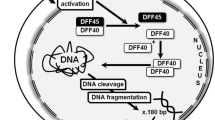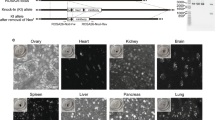Summary
The alkylation of chromatin constituents (DNA, histones and nonhistones) in liver cell nuclei was investigated at various times after intraperitoneal injection of rats with 3H-cyclophosphamid. The highest alkylation was found in the DNA, the lowest in the histones; the euchromatic portions were alkylated several times higher compared to those of the heterochromatin. The eventual elimination of 3H-activity with time indicates that cyclophosphamid leads to repair processes in the DNA, this conclusion being supported by other experimental observations. In some of the 16 subfractions of the nonhistone proteins, alkylated portions are apparantly eliminated by normal protein turnover; however, in other nonhistones this elimination is inhibited, whereby in one subfraction it seems to be accelerated. The results of analog experiments with 14C-tryptophan as a precursor for nonhistone protein synthesis serve as a reference for this. In supplementary in-vitro model experiments using triaziquon as an alkylating agent indications for DNA-Protein-cross-links in chromatin could be obtained by the technique of X-ray low angle scattering, and according to sedimentation behaviour.
Zusammenfassung
Zu verschiedenen Zeiten nach der i.p. Verabfolgung von 3H-Cyclophosphamid an Ratten wurde (über die Bestimmung des 3H-Gehaltes) die Alkylierung der Chromatinbausteine DNA, Histone und Nichthistonproteine in den Zellkernen der Leber untersucht. Die höchste Alkylierung fand sich in der DNA, die geringste in den Histonen; die euchromatischen Anteile wurden um ein Vielfaches stärker alkyliert als die heterochromatischen. Der zeitliche Verlauf der Eliminierung der 3H-Aktivität weist, ergänzt durch andere Befunde, darauf hin, daß es nach Einwirkung von Cyclophosphamid an der DNA zu Repariervorgängen kommt. Bei 16 untersuchten Unterfraktionen der Nichthistone werden die alkylierten Anteile zum Teil offenbar über den normalen Proteinumsatz eliminiert; diese Eliminierung ist bei einigen der Nichthistone jedoch gehemmt, dagegen bei einer Unterfraktion anscheinend beschleunigt. Als Bezugssystem für diese Untersuchungen dienten die Ergebnisse analoger Versuche mit 14C-Tryptophan als Vorstufe der Nichthistonproteine. Bei ergänzenden in-vitro-Modellversuchen mit Triaziquon als Alkylans konnten mit Hilfe der Röntgenkleinwinkelstreuungstechnik und aufgrund des Sedimentationsverhaltens Hinweise für das Vorliegen von DNA-Protein-Vernetzungen im Chromatin gewonnen werden.
Similar content being viewed by others
Literatur
Alam,S.N., Alam,R.A., Harbers,E.: Studies on deoxyribonucleoproteins. VII. Purification of deoxyribonucleoprotein by carrier-free continous electrophoresis. Biochim. Biophys. Acta 209, 550–558 (1970)
Aleksanyan,V.I., Vorob'ev,V.I., Fedorov,B.A.: Studies on deoxyribonucleoprotein structure. Small angle X-ray scattering in solutions of various ionic strengths. Biopol. 14, 1133–1142 (1975)
Brock,N., Hohorst,H.-J.: Über die Aktivierung von Cyclophosphamid in Warmblüterorganismen. Naturwiss. 49, 610–611 (1962)
Brock,N., Hohorst,H.-J.: Über die Aktivierung von H3-Cyclophosphamid in vivo und in vitro. Arzneimittelforschg. (Drug Res.) 13, 1021–1030 (1963)
Dastugue,B., Hanoune,J., Kruh,J.: Synthesis and turnover of liver chromatin acidic proteins. FEBS Lett. 19, 65–68 (1971)
Dice,J.F., Schimke,R.T.: Turnover of chromosomal proteins from rat liver. Arch. Biochem. Biophys. 158, 97–105 (1973)
Fox,M., Fox,B.W.: Repair replication and unscheduled DNA synthesis in mammalian cell lines showing differential sensitivity to X-rays and sulphur mustard. Mutation Res. 19, 119 (1973)
Frenster,J.H., Allfrey,V.G., Mirsky,A.E.: Repressed and active chromatin isolated from interphase lymphocytes. Proc. nat. Acad. Sci. (Wash.) 50, 1026–1032 (1963)
Gerner,E.W., Humphrey,R.M.: The cell-cycle phase synthesis of nonhistone proteins in mammalian cells. Biochim. Biophys. Acta 331, 117–127 (1973)
Goodman,J.I., Potter,V.R.: Evidence for DNA repair synthesis and turnover in rat liver following ingestion of 3′-methyl-4-dimethylaminoazobenzene. Cancer Res. 32, 766–775 (1972)
Grunicke,H., Bock,K.W., Becher,H., Gäng,V., Schnierda,J., Puschendorf,B.: Effect of alkylating antitumor agents on the binding of DNA to protein. Cancer Res. 33, 1048–1053 (1973)
Hannig,K.: Eine Neuentwicklung der trägerfreien kontinuierlichen Elektrophorese. Z. physiol. Chem. 338, 211–227 (1964)
Harbers,E.: Grundlagen der Auswertung von biologischen und medizinischen Versuchen mit Radioisotopen. Klin. Wochenschr. 32, 392–103 (1954)
Harbers,E.: Zur Rolle von Eu- und Heterochromatin bei Kanzerogenese und Wirkung einiger Zytostatika. Fortschr. Krebsforschg., Molekularbiol., Wachstum, Klinik (10. wiss. Tagung d. Zentralausschusses f. Krebsbekämpfg. u. Krebsforschg. e. V., Berlin 1968), S. 321–331. Schattauer Verlag, Stuttgart-New York, 1969
Harbers,E., Hollandt,H., Eilers-König,C., Schneider,R., Struttmann,C., Warnecke,P.: Studies on deoxyribonucleoproteins. IX. Subfractions of deoxyribonucleoproteins from rat and mouse liver. Z. physiol. Chem. 356, 671–675 (1975)
Harbers,E., Lederer,B., Sandritter,W., Spaar,U.: Untersuchungen an Nucleohistonen. IV. „Heterochromatisierung“ in der Rattenleber während der Carcinogenese. Virchows Arch. Abt. B, Zellpath. 1, 98–106 (1968)
Harbers,E., Vogt,M.: Studies on the properties of nucleohistones. In: „The cell nucleus—metabolism and radiosensitivity, p. 165–177. Taylor & Francis, Ltd., London, 1966
Harrap,K.R., Gascoigne,E.W.: The interaction of bifunctional alkylating agents with the DNA of tumour cells. Eur. J. Cancer 12, 53–59 (1976)
Higgins,G.M., Anderson,R.M.: Experimental pathology of liver. Restoration of the liver of the white rat following partial surgical removal. Arch. Path. 12, 186–202 (1931)
Kohn,K.W., Steigbigel,N.H., Spears,C.O.: Cross-linking and repair of DNA sensitive and resistant strains of E. coli treated with nitrogen mustard. Proc. nat. Acad. Sci. (Wash.) 53, 1154–1157 (1965)
König,R., Stegemann,H., Francksen,H., Paul,H.L.: Protein subunits on potato virus X group. Determination of the molecular weights by polyacrylamide electrophoresis. Biochim. Biophys. Acta 207, 184–189 (1970)
Kratky,O.: Neues Verfahren zur Herstellung von blendenstreuungsfreien Röntgenkleinwinkelaufnahmen. Z. Elektrochem. 58, 49–53 (1954)
Kratky,O.: Neues Verfahren zur Herstellung von blendenstreuungsfreien Röntgenkleinwinkelaufnahmen, IV. Z. Elektrochem. 62, 66–73 (1958)
Kratky,O.: X-ray small angle scattering with substances of biological interest in diluted solutions. Progr. Biophys. 13, 105–173 (1963)
Lawley,P.D.: Effects of alkylating agents on nucleic acids and their relation to other mutagens. In: “The molecular basis of neoplasia”, p. 123–132. Univ. of Texas Press, Austin, Texas, 1962
Lawley,P.D., Brookes,P.: Cytotoxicity of alkylating agents towards sensitive and resistant strains of Escherichia coli in relation to extent and mode of alkylation of cellular macromolecules and repair of alkylation lesions in deoxyribonucleic acid. Biochem. J. 109, 433–439 (1968)
Leopold,H.: Elektronische Programmiereinrichtung zur Vermessung von Röntgenkleinwinkelstreukurven. Z. f. angew. Physik 25, 81–85 (1968)
Painter,R., Cleaver,J.: Repair replication, unscheduled DNA synthesis, and the repair of mammalian DNA. Radiat. Res. 37, 451–466 (1969)
Panyim,S., Chalkley,R.: Heterogeneity of histones. I. Quantitative analysis of calf thymus histones in very long polyacrylamide gels. Biochem. 8, 3972–3979 (1969)
Regan,J., Setlow,R., Ley,R.: Normal and defective repair of damaged DNA in human cells: A sensitive assay utilizing the photolysis of bromodeoxyuridine. Proc. nat. Acad. Sci. (Wash.) 68, 708–712 (1971)
Rutman,R.J., Steele,W.J., Price,C.C.: Observations on the in vivo alkylation of Ehrlich tumor cell DNA by nitrogen mustards. Biochem. biophys. Res. Commun. 4, 278–282 (1961)
Schachman,H.K.: Ultracentrifugation in biochemistry. Academic Press, New York-London, 1959
Seale,R.L.: Conservation of non-histone chromatin proteins during growth in HeLa cells. Biochem. biophys. Res. Commun. 63, 140–148 (1975)
Sokolov,N.A., Piker,E.G., Zakaryan,M.S., Blinova,G.G., Tseitlin,P.I.: Formation of stable DNA-protein bonds by the action of a bifunctional alkylating mutagen (Embichin-HN2) on chromatin. Byull. Eksp. Biol. Med. 79, 42–44 (1975)
Steele,W.K.: Cross-linking of DNA to nuclear proteins by difunctional alkylating agents. Proc. Amer. Assoc. Cancer Res. 3, 364 (1962)
Stein,G.S., Matthews,D.E.: Nonhistone chromosomal protein synthesis: Utilization of preexisting and newly transcribed messenger RNA's. Science 181, 71–73 (1973)
Stein,G.S., Thrall,C.L.: Uncoupling of nonhistone chromosomal protein synthesis and DNA replication in human diploid WI-38 fibroblasts. FEBS Lett. 34, 35–39 (1973)
Strauss,B.S.: Repair of DNA in mammalian cells. Life Sci. 15, 1685–1693 (1974)
Trams,E.G., Nadkarni,M.V., Smith,P.K.: On the mechanism of action of the alkylating agents. I. Interaction of alkylating agents with nucleic acids. Cancer Res. 21, 560–566 (1961)
Warnecke,P., Kruse,K., Harbers,E.: Studies on deoxyribonucleoproteins. VIII. Isolation and characterization of nonhistone proteins from euchromatic and heterochromatic deoxyribonucleoprotein of rat liver. Biochim. Biophys. Acta 331, 295–304 (1973)
Weber,K., Osborn,M.: The realibilily of molecular weight determinations by dodecyl-sulfate polyacrylamide gel-electrophoresis. J. biol. Chem. 244, 4406–4412 (1969)
Wenzel,R.: Untersuchungen zur Wirkungsweise alkylierender Cytostatica: Einfluß auf das Verhalten der Desoxyribonucleoproteine bei der trägerfreien Elektrophorese. Dissertationsschrift (52 S.) Univ. Göttingen, 1970
Wheeler,G.P., Alexander,J.A.: Studies with mustards. V. In vivo fixation of C14 of labeled alkylating agents by bilaterally grown sensitive and resistant tumors. Cancer Res. 24, 1331–1337 (1964)
Zubay,G., Doty,P.: The isolation and properties of deoxyribonucleoprotein particles containing single nucleic acid molecules. J. mol. Biol. 1, 1–20 (1959)
Author information
Authors and Affiliations
Rights and permissions
About this article
Cite this article
Harbers, E., Warnecke, P., Hollandt, H. et al. Untersuchungen zur Alkylierung von Chromatin in der Rattenleber nach Gabe von 3H-Cyclophosphamid — „Feinverteilung“ und Kinetik. Z. Krebsforsch. 88, 237–254 (1977). https://doi.org/10.1007/BF00305362
Received:
Accepted:
Issue Date:
DOI: https://doi.org/10.1007/BF00305362




